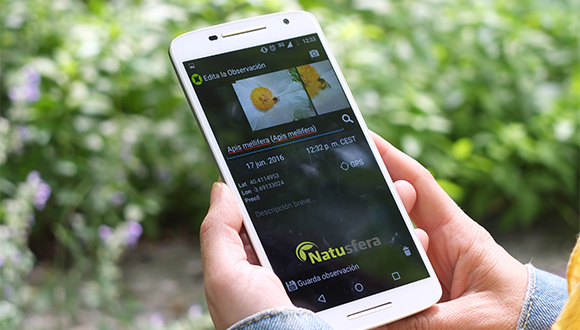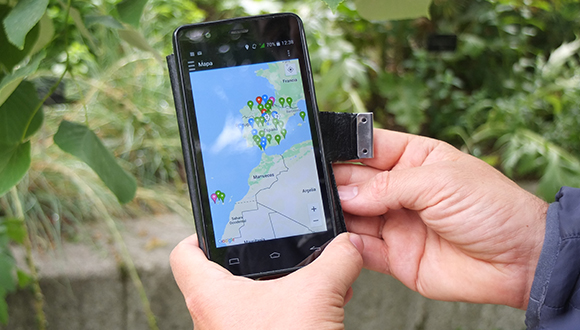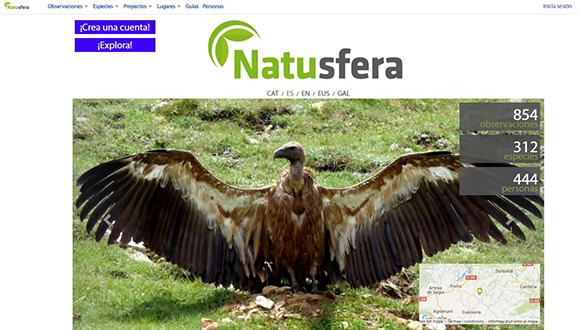Meet Natusfera: a new virtual platform which will connect nature lovers from all over Europe
Created by CREAF and GBIF.ES, Natusfera consists of a web portal and application for mobile devices which will host information about living beings observed in nature including photo sharing and location. The European Citizen Science Association considers Natusfera to be a benchmark model for initiatives of this type, and has proposed that it be translated into as many languages as possible.

Beginning today, anyone who would like to create and share observations of nature, meet other naturalists, or learn about the natural world can sign up for Natusfera, download the app, and start creating their own projects or virtual field notebooks.
Natusfera, presented in an opening ceremony at the Royal Botanical Garden of the Spanish National Research Council (CSIC by its Spanish acronym), is a citizen science platform created by CREAF and coordinated by the Spanish node of the Global Biodiversity Information Facility (GBIF). The platform is currently available in the Castilian, Galician, Catalan, Basque, and English languages. Its technology has been adapted from iNaturalist, a platform originating from the United States which has been a success there and in Mexico. Natusfera was created with the hope that it will become the foremost citizen science platform for studying biodiversity in Europe.
Natusfera is a digital platform, built on open source code and very easy to use, requiring no special technical knowledge. "It is very important that it is within the reach of any anyone, allowing the uploading of photos or even sounds of living beings found in nature; they can be identified, organized, and added to lists or personalized projects. The platform also serves as a virtual network where all of the users are connected and help each other to identify species or to fill in data for multiple projects. This a very helpful digital tool serving society," says Jesús Muñoz, director of the Royal Botanical Garden (CSIC, Spain) and head of the Coordination Unit of the National Node for GBIF Spain.

According to Bernat Claramunt, CREAF researcher leading the project, "we have created a platform that will be capable of growth according to needs of its users, one of whose main objectives is the creation of synergies and communication with other, similar projects at local, national, and international levels."
Data uploaded by citizens to Natusfera will support scientific projects
It is intended that the Big Data generated by users of Natsufera, following validation by experts within the community, will be included in databases connected to the GBIF and therefore be accessible through the organization's own data portals.
According to Cristina Villaverde, technical coordinator for GBIF Spain, "these local-scale data will be backed by a global organization which publishes biodiversity information from all over the world and is already receiving information from thousands of scientific projects." She adds, "with this we will give small collectives with limited infrastructure the opportunity to create their own projects and integrate their data into global platforms."

Natusfera aims to be a central tool for biodiversity and citizen science in Europe
Some members of the founding team of Natusfera are directly involved in the managing bodies of the European Citizen Science Association (ECSA). Jaume Piera, researcher at the Institute for Marine Sciences (ICM for its Spanish Acronym) and CREAF and founding member of the ECSA, comments, "Natusfera will be the first platform supported by the ECSA and will be made available to any group in Europe wanting to create biodiversity projects with citizens."
ECSA would like to see Natusfera translated into as many European languages as possible. For this, the collaborative translation platform Crowdin will be used. Also, EU-BON, a large European project whose objective is to create a European biodiversity observation network, has already expressed positive views on the use of Natasfera as a central citizen science platform.
The Natasfera platform is financed by the Spanish Foundation for Science and Technology (FECYT by its Spanish acronym), Obra Social "La Caixa", the National Node for Biodiversity in Spain, GBIF.ES, and ICM-CSIC. CREAF and GBIF.ES are responsible for project administration, coordination, and maintenance and management of contents.
Here you can see the Natusfera flyer. You can also download the mobile device application for Android.







